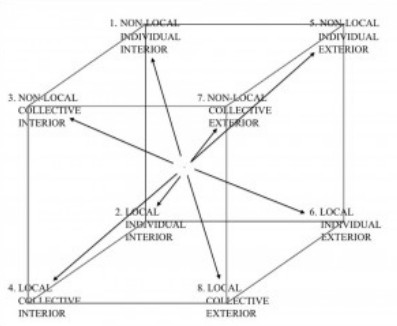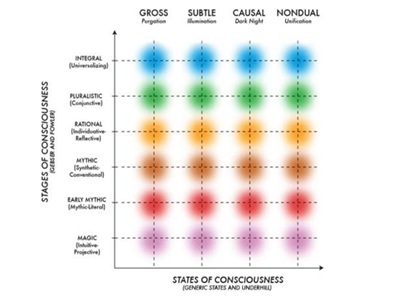|
TRANSLATE THIS ARTICLE
Integral World: Exploring Theories of Everything
An independent forum for a critical discussion of the integral philosophy of Ken Wilber
  Frank Visser, graduated as a psychologist of culture and religion, founded IntegralWorld in 1997. He worked as production manager for various publishing houses and as service manager for various internet companies and lives in Amsterdam. Books: Ken Wilber: Thought as Passion (SUNY, 2003), and The Corona Conspiracy: Combatting Disinformation about the Coronavirus (Kindle, 2020). Frank Visser, graduated as a psychologist of culture and religion, founded IntegralWorld in 1997. He worked as production manager for various publishing houses and as service manager for various internet companies and lives in Amsterdam. Books: Ken Wilber: Thought as Passion (SUNY, 2003), and The Corona Conspiracy: Combatting Disinformation about the Coronavirus (Kindle, 2020).
Check out my other conversations with ChatGPT Saving the AQAL Cube from Quantum MystiqueFrank Visser / ChatGPT
 When Lex Neal proposed his AQAL Cube two decades ago, he sought to correct a shortcoming in Ken Wilber's celebrated four-quadrant model of reality.[1] The AQAL (All Quadrants, All Levels) diagram elegantly cross-classifies existence along two axes: interior-exterior and individual-collective. Yet for all its integrative power, Neal saw it as incomplete—a two-dimensional map that, ironically, left consciousness itself implicit. Neal's solution was deceptively simple: add a third axis. By turning Wilber's square into a cube, he could represent not just perspectives (the four quadrants) and developmental levels (the vertical dimension), but also the depth of awareness through which all experience arises. This “Z-axis of consciousness” would extend from the dim states of deep sleep up through waking, witnessing, and nondual awareness—the very terrain Wilber treated as states rather than structures.

The AQAL Cube
Neale's AQAL Cube builds directly on Ken Wilber's 8 primordial perspectives, as outlined in Integral Spirituality, translating them into 8 spatially distinct octants. By formalizing these perspectives into a cubic structure, Neale makes the underlying framework of AQAL more explicit and visually graspable. This approach clarifies the relationships among quadrants, levels, lines, and states, without fundamentally altering Wilber's original theory. In effect, the Cube functions as a conceptual crystallization of Wilber's ideas—emphasizing symmetry and coherence while retaining the integral vision of multiple, intersecting dimensions of reality. From the Wilber-Combs Lattice to the AQAL CubeWilber himself recognized the need to distinguish temporary state experiences from enduring stage attainments. His collaboration with Alan Combs produced the Wilber-Combs Lattice, a two-dimensional matrix that plotted developmental stages (vertical axis) against states of consciousness (horizontal axis).

The Wilber-Combs Lattice
The Lattice clarified how a person at any stage can experience a high state—for instance, a mythic believer might have a genuine nondual glimpse—yet interpret it through their current worldview. It thus preserved Wilber's developmental realism while honoring the universality of mystical experience. Neal's AQAL Cube performs a similar separation, but in a more geometrically integrated way. Instead of treating states as an overlay on stages, he embeds them as an orthogonal dimension of the quadrants themselves. Every phenomenon—whether individual or collective, interior or exterior—can now be viewed not just developmentally but also through the lens of awareness depth. In that sense, Neal's Cube could be seen as a 3D version of the Wilber-Combs lattice, folding it back into the core AQAL geometry rather than leaving it as an auxiliary chart. It elegantly unifies Wilber's two main diagrammatic innovations. Consciousness: Axis or Quadrant?Critics might object that consciousness is already accounted for in Wilber's Left-Hand quadrants (the interiors). But Neal's move is more subtle. Wilber's Left-Hand domains map the contents and structures of experience—the phenomenological and cultural interiors—not consciousness as such. Neal argues that Wilber's model remains epistemologically complete but ontologically incomplete, because it fails to spatialize the field of awareness itself. By adding a Consciousness axis, Neal turns awareness from background presupposition into foreground variable. The model now has a way to show degrees of awakening within each quadrant, rather than implying that consciousness only “lives” in the Left-Hand side. Rethinking “Nonlocal” ConsciousnessWhere Wilber tended to speak of “Spirit” in perspectival or phenomenological terms, Neal went further: he sought to anchor consciousness in the “New Physics.” Drawing on the vocabulary of quantum theory, he described the deeper reaches of awareness as nonlocal—a kind of Planck-scale consciousness field pervading the cosmos. Yet this borrowing of scientific language introduces a semantic confusion. In physics, nonlocality describes correlations that do not diminish with spatial distance—a strictly technical concept. Applied to consciousness, however, it risks suggesting that awareness literally transcends space and time, merging into a universal field. Phenomenologically, though, consciousness is always local. It is here, now, and embodied—the immediate field through which a particular subject encounters reality. To call that “nonlocal” is to turn phenomenology into cosmology by metaphorical drift. A more accurate term would be nonphysical. Our interiors are not spatially extended or measurable; they are real, but nonphysical. By reserving “nonlocal” for physics and using “nonphysical” for consciousness, we preserve clarity: interiority is genuine and irreducible, yet always situated in perspective. Seen this way, Neal's Cube can be read without metaphysical inflation. Its added dimension expresses not a cosmic omnipresence but the nonphysical depth of awareness within each quadrant. Consciousness thus becomes the condition for locality, not its negation. Toward a Clean Integral GeometryIf Wilber's map is a flat coordinate grid, Neal's cube makes it volumetric—restoring the “space of consciousness” to its rightful place. One can appreciate this as a natural evolution of Integral Cartography rather than a deviation from it. Freed from its quantum excesses, the AQAL Cube becomes a philosophically cleaner model—a rational geometry of experience that bridges Wilber's developmental emphasis with the contemplative insight that consciousness is both the medium and measure of all quadrants. Consciousness Returns Through the Back DoorKen Wilber's later Integral Post-Metaphysics tried to purge AQAL of ontological claims. “Spirit” and “consciousness” became not entities but perspectives—linguistic enactments rather than pre-given realities. This preserved philosophical rigor but left the model's ultimate referent curiously thin. Lex Neal's AQAL Cube quietly reverses this deflation. By granting consciousness its own axis, he restores what Wilber bracketed out—not as supernatural substance, but as the condition of all appearing. Consciousness becomes geometrically explicit again, without collapsing into metaphysical dogma. In that sense, Neal's Cube represents a return of ontology through the back door—a way to reinstate being without abandoning phenomenological modesty. Where Wilber says, “All that exists is perspective,” Neal replies, “Every perspective arises in awareness.” The difference is subtle yet profound: it re-roots Integral Theory in the immediacy of experience while sparing it from the rhetorical inflation of quantum mystique. Epilogue: The Fate of Integral GeometryLex Neal's AQAL Cube joins a small but revealing lineage of geometric reinterpretations of Wilber's model. Steve McIntosh envisioned the Integral framework as an evolutionary spiral, emphasizing dynamic growth rather than static mapping. Sean Esbjörn-Hargens reformulated it into Integral Pluralism, showing how multiple ontologies and methodologies co-exist within the quadrants. Neal's contribution belongs in that same family of creative extrapolations—not as a rival to Wilber, but as an experiment in Integral geometry. Where McIntosh added motion and Esbjörn-Hargens added pluralism, Neal added depth: the inward dimension of consciousness as a spatial metaphor. If freed from its “New Physics” packaging, the AQAL Cube can still serve as a clarifying diagram for those who sense that consciousness is not just one quadrant among others, but the light that illumines them all. It reminds us that Integral Theory, for all its cartographic precision, remains a map of reality as experienced—and thus, ultimately, a map drawn on the transparent screen of awareness itself.
NOTES[1] See Neale's essays on Integral World, and also this introductory essay: "The AQAL Cube for Dummies", Integral Leadership Review, June 2013.
Comment Form is loading comments...
|